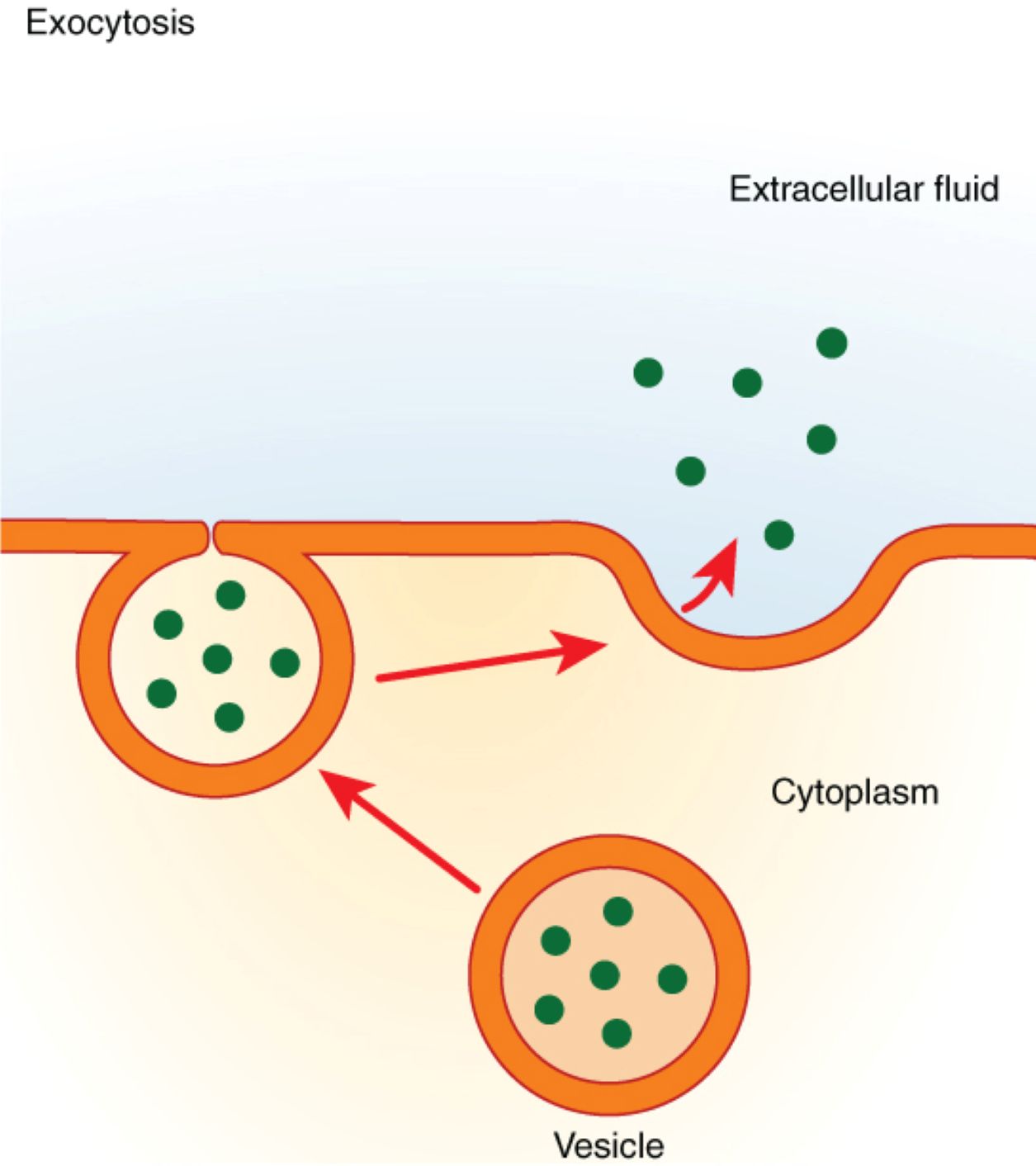Exocytosis is a fundamental active transport process that enables cells to expel materials, such as hormones or waste, into the extracellular environment, playing a crucial role in cellular communication and homeostasis. In this process, a vesicle inside the cell fuses with the plasma membrane, releasing its contents into the extracellular fluid, as depicted in the diagram. This article provides a detailed exploration of exocytosis, its anatomical and physical mechanisms, and its significance in various physiological functions.

Labeled Components of Exocytosis
Exocytosis
Exocytosis is the process by which cells release materials packaged in vesicles into the extracellular space. It is an energy-dependent mechanism that ensures the secretion of substances like neurotransmitters or hormones.
Extracellular Fluid
The extracellular fluid is the external environment surrounding the cell where the contents of the vesicle are released during exocytosis. It serves as the medium through which secreted substances travel to target cells or are removed from the body.
Cytoplasm
The cytoplasm is the intracellular environment where vesicles are formed and transported before exocytosis. It houses the cellular machinery, such as the Golgi apparatus, that prepares materials for secretion.
Vesicle
A vesicle is a membrane-bound sac within the cell that contains materials destined for export, such as proteins or signaling molecules. During exocytosis, the vesicle membrane fuses with the plasma membrane, releasing its contents.
The Anatomy and Physical Properties of Exocytosis
Structure of the Vesicle and Plasma Membrane
The structural components involved in exocytosis are intricately designed for material release. Here’s an overview:
- The vesicle is formed by the Golgi apparatus or endoplasmic reticulum, encapsulating materials like enzymes or hormones in a lipid bilayer.
- The plasma membrane, which the vesicle fuses with, is a flexible lipid bilayer that allows for membrane fusion and content release.
- Proteins such as SNARE complexes on the vesicle and plasma membrane facilitate the fusion process.
- The cytoplasm provides the environment for vesicle transport, often involving microtubules and motor proteins like kinesin.
Physical Mechanisms of Exocytosis
The physical process of exocytosis involves precise molecular interactions. Key aspects include:
- The vesicle approaches the plasma membrane, guided by cytoskeletal elements, and aligns for fusion.
- Energy from ATP drives the fusion of the vesicle membrane with the plasma membrane, releasing its contents into the extracellular fluid.
- Calcium ions often act as a trigger, binding to proteins that initiate the fusion process.
- After release, the vesicle membrane is incorporated into the plasma membrane, which may later be recycled via endocytosis.
Functional Roles of Exocytosis in Cellular Processes
Secretion of Signaling Molecules
Exocytosis is crucial for the release of signaling molecules that regulate cellular communication. This process includes:
- In neurons, exocytosis releases neurotransmitters into the extracellular fluid, enabling synaptic transmission.
- Endocrine cells use exocytosis to secrete hormones like insulin, which are packaged in vesicles by the Golgi apparatus.
- This process ensures rapid and targeted delivery of signaling molecules to their destinations.
- The release from the cytoplasm into the extracellular fluid supports systemic functions like glucose regulation.
Waste Removal and Cellular Maintenance
Exocytosis helps cells eliminate waste and maintain their internal environment. Key points include:
- Cells expel metabolic byproducts or toxins via vesicles, preventing accumulation in the cytoplasm.
- In immune cells, exocytosis releases enzymes or cytotoxic molecules to destroy pathogens.
- The process also recycles membrane components, maintaining plasma membrane integrity.
- This expulsion into the extracellular fluid ensures cellular health and prevents toxicity.
Physiological Implications
Exocytosis has significant impacts across various physiological systems. Here’s how:
- In the digestive system, exocytosis releases digestive enzymes from pancreatic cells into the extracellular fluid for nutrient breakdown.
- In the immune system, it facilitates the release of cytokines, coordinating immune responses.
- The process supports muscle contraction by releasing calcium from the sarcoplasmic reticulum in muscle cells.
- In the skin, exocytosis delivers lipids to form a protective barrier, maintaining hydration and defense.
Conclusion
Exocytosis is a vital cellular process that allows the release of materials from vesicles in the cytoplasm into the extracellular fluid, supporting communication, waste removal, and physiological balance. By fusing with the plasma membrane, exocytosis ensures the precise delivery of essential substances, maintaining cellular and systemic health. Understanding this mechanism provides valuable insights into the dynamic processes that sustain life at the cellular level and their broader implications in biological systems.
